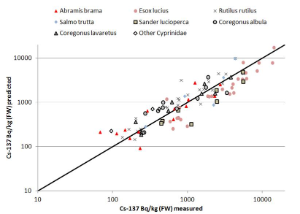Novel approaches to estimate radionuclide transfer to wildlife and human foodstuffs
We need to be able to assess the transfer of a wide range of radionuclides to many different species of terrestrial and aquatic wildlife and human foodstuffs. Realistically, data will never be gathered to cover all of these.
Many models used for the prediction of the transfer of radionuclides through human foodchains, and virtually all of those applied to estimate the internal exposure of wildlife, use equilibrium activity concentration ratios (CR). For crops in human foodchain models the CR is the ratio of activity concentrations in the edible portion of the plant to that in the soil. For wildlife a ratio (CRwo-media) between the activity concentration in the whole organism to that in the media (e.g. soil or water) is most often used. This parameter is simplistic, combining many biological and environmental processes, but has generally been considered to be a pragmatic approach. A justifiable criticism is that CR values are highly variable because of the site specificity of radionuclide transfer (e.g. soil properties or water chemistry). In the case of wildlife this leads to predictions by different models which often vary by 2-5 orders of magnitude for the same assessment.
During TREE we developed and tested: (1) an alternative approach to CR; (2) robust methods to extrapolate available knowledge such that predictions for species-radionuclide combinations for which we have no data can reliably be made.
Hypotheses
- Radionuclide activity concentrations in crop plants and terrestrial and aquatic wildlife can be predicted using phylogenetically-derived relationships
- Ionomic relationships can be established to enable knowledge of one radionuclide to improve predictions of the activity concentrations of other radionuclides in human foodstuffs and wildlife
Plants
Phylogeny is the study of evolutionary relationships among groups of organisms. Phylogenetic variation occurs in shoot mineral and heavy metal concentrations of angiosperms (flowering plants). For radionuclides we have established that there are differences between major taxonomic groups in the transfer to angiosperms of Cs, Sr, Cl and Tc (Willey et al. 2010; Willey & Fawcett 2005; 2006). Though these were based on a limited compilation of the available data and focused on flowering plants these initial studies suggest that more complete phylogenetic analyses could provide a generic model which can be applied to predict activity concentrations in a wide variety of plant types.
Using field and laboratory studies we conducted a comprehensive investigation of phylogenetic effects in uptake of the elements of radionuclides considered in the soil biogeochemical – plant uptake studies (i.e. Tc, I, U and Se) by supplementing the data generated from the pot experiments in work package 1 with dedicated greenhouse experiments and previously unused data. Data from vascular plant phyla other than angiosperms (e.g. Pteridophyta, Pinophyta) were included where available. The isolation of phylogenetic patterns in radionuclide uptake by plants will enable extrapolation of results obtained from the soil biogeochemical – plant uptake studies to a wide range of crops and other plants and provide a model to predict transfer parameters for crops for which data do not exist.
Recent research has suggested the existence of identifiable plant ionome groupings, i.e. the propensity of different plant species to have similar elemental concentrations despite significant variation in element availability in the environment (Willey 2012).
We determined radiologically-relevant groupings of organisms based on their ionomes by combining our results and existing databases in meta-analyses with data emerging from ionomic studies on stable elements (e.g. www.ionomicshub.org ). A particular focus of our investigations was the behaviour of ratios of elements (stoichiometry). Ratios of N:P:C in particular have long been known to have predictable patterns in plants. However, stoichiometry has recently been applied to other elements, in particular Ca/P and K, which is promising for our purposes given that Ca and K are analogues of Sr and Cs respectively. Similar analyses of stable element data for fish and some other organisms have been reported.
Understanding ionomic effects in a range of organisms enabled us to make predictions of transfer for radionuclides for which there are few data, but for which elements with similar ionomic behaviour have been characterised. In addition to plants we evaluated the potential applicability of ionomic techniques for predicting radionuclide activity concentrations in wildlife and farm animal produce using available datasets.
Wildlife
Building upon the work demonstrating phylogenetic relationships of element/radionuclide transfer to plants, we have suggested an alternative to the CRwo-media approach for wildlife and tested this approach for Cs and freshwater. These analyses used Residual Maximum Likelihood (REML) mixed-model regression. The estimated relative values resulting from REML modelling provide relative ratios of concentration between different taxa groups which can then be applied across different sites. The approach requires data for one common species from any site to be available.

The focus of wildlife studies in TREE was to try to establish REML models for a wide range of radiologically significant elements for terrestrial species. To do this we utilised an existing database that TREE members have co-ordinated the development of and conducted field sampling campaigns. The sampling focused on species representative of the ICRP's terrestrial Reference Animals and Plants (RAPs) which are defined as the taxonomic families: Apidea, Cervidae, Anatidae, Lumbricidae, Ranidae, Pinaceae, Muridae and Poaceae. To expand the range of sites and analytes we collaborated with the EU funded COMET programme. Our sampling sites were within the Chornobyl Exclusion Zone, UK forest sites and a Spanish semi-natural grassland. Stable elements and radionuclides will be determined in the samples.

Whilst the focus of our sampling was terrestrial species through collaboration with our international project partners we also established REML models for marine and freshwater species. The approaches described above were successfully tested using independent data and have made a very significant step forward in predictive capability for environmental radioactivity.